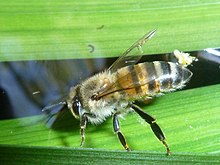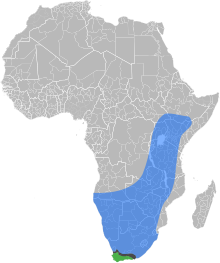
Back Apis mellifera scutellata Catalan Včela medonosná středoafrická Czech Африкăлла хурт-хăмăр CV Ostafrikanische Hochlandbiene German Apis mellifera scutellata Greek Apis mellifera scutellata Spanish Apis mellifera scutellata French Apis mellifera scutellata Icelandic Apis mellifera scutellata Italian アフリカミツバチ Japanese
| East African lowland honey bee | |
|---|---|

| |
| Worker bee (female) drinking water | |
| Scientific classification | |
| Domain: | Eukaryota |
| Kingdom: | Animalia |
| Phylum: | Arthropoda |
| Class: | Insecta |
| Order: | Hymenoptera |
| Family: | Apidae |
| Genus: | Apis |
| Species: | |
| Subspecies: | A. m. scutellata
|
| Trinomial name | |
| Apis mellifera scutellata Lepeletier, 1836
| |

| |
| The natural ranges of the
East African lowland honey bee,
the Cape honey bee, and the
contact zone where the two subspecies overlap and hybridize
| |
The East African lowland honey bee (Apis mellifera scutellata) is a subspecies of the western honey bee. It is native to central, southern and eastern Africa, though at the southern extreme it is replaced by the Cape honey bee (Apis mellifera capensis).[1] This subspecies has been determined to constitute one part of the ancestry of the Africanized bees (also known as "killer bees") spreading through North and South America.[2]
The introduction of the Cape honey bee into northern South Africa poses a threat to East African lowland honey bees. If a female worker from a Cape honey bee colony enters an East African lowland honey bee nest, she is not attacked, partly due to her resemblance to the East African lowland honey bee queen. As she is capable of parthenogenetic reproduction, she may begin laying eggs which hatch as "clones" of herself, which will also lay eggs, causing the parasitic A. m. capensis workers to increase in number. The death of the host colony results from the dwindling numbers of A. m. scutellata workers that perform foraging duties (A. m. capensis workers are greatly under-represented in the foraging force), the death of the queen, and, before queen death, competition for egg laying between A. m. capensis workers and the queen. When the colony dies, the capensis females will seek out a new host colony.[3]
- ^ Ruttner, F. 1988: Biogeography and Taxonomy of Honeybees. Springer Verlag, Berlin
- ^ Cite error: The named reference
Smithsonian Marine Stationwas invoked but never defined (see the help page). - ^ [1] Moritz, R.F.A (2002) The Cape honeybee Apis mellifera capensis From laying workers to social parasites Apidologie Special Issue 33 (2), 99–244